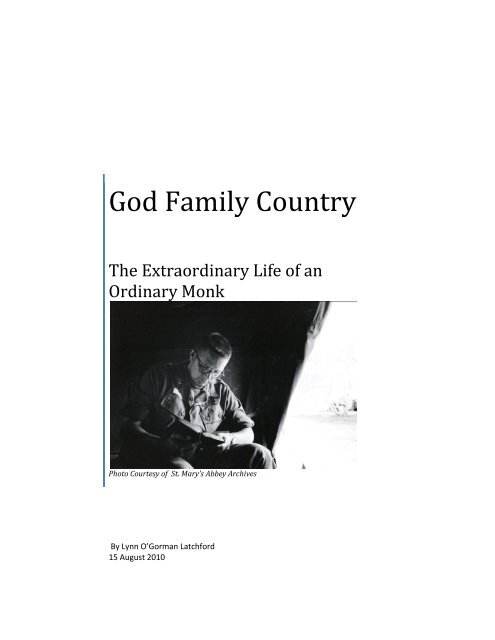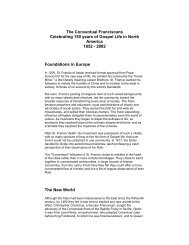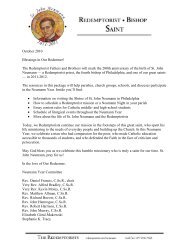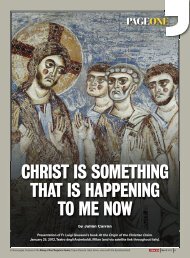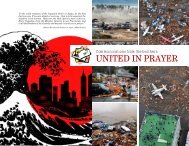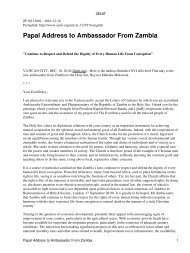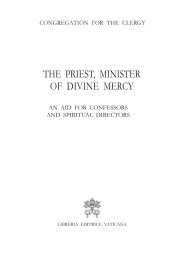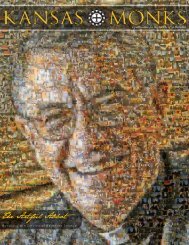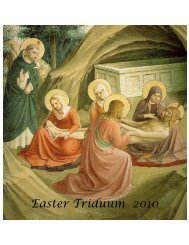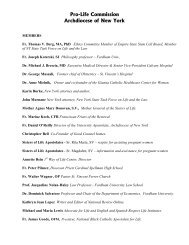Abbot Thomas Confroy 2010.pdf - Communio
Abbot Thomas Confroy 2010.pdf - Communio
Abbot Thomas Confroy 2010.pdf - Communio
You also want an ePaper? Increase the reach of your titles
YUMPU automatically turns print PDFs into web optimized ePapers that Google loves.
God Family CountryThe Extraordinary Life of anOrdinary MonkPhoto Courtesy of St. Mary’s Abbey ArchivesBy Lynn O’Gorman Latchford15 August 2010
Photo Courtesy St. Mary’s Abbey ArchivesIt was near Easter in 1966. The unit was surprised, ambushed and surrounded. Fr.Tom arrived with the resupply helicopter bringing water, ammunition, medics and whatcould be found of God in this dense jungle. Many boys had been killed, but many morewere wounded. Fr. Tom closed his eyes in prayer with the whomp, whomp, whompsound of the helicopter overhead as he reached into his bag for anointing oil. His was aministry of presence. “I am here.” He comforted the sick and dying, reaching over eachone lying as they were bleeding and alone, moaning and calling out for their mothers,their wives, as Fr. Tom anointed their heads with oil and said prayers of comfort. Thewounded and killed had been gathered into a makeshift triage unit, the able bodiedsurrounding them in a circle to protect them from the Vietcong that had attacked the unit.Tom listened to the soldiers’ questions of, “How did this happen to us?” and “Who madethe mistake that landed us in the middle of this?” Fr. Tom’s job was to listen.2
And as a Benedictine monk in combat fatigues with boots molded to his feet and aconstant trickle of sweat pooling in the small of his back, he listened with the ear of hisheart. Especially here in thejungle, trapped as he was withhis men, ministering to them asthey called for home and theirfamilies in the midst oftragedy. He was their last linkwith all that was good.Photo Courtesy of St. Mary’s Abbey ArchivesTom’s own family was so very different from many of these soldiers and hisfriends and neighbors. His earliest memories are of running in the door after school andseeing his mother kneeling at prayer, a Benedictine prayer book and rosary in her hands.She was an Oblate to Newark Abbey and with 11 children, prayer and the sacramentswere a necessary order in her household. He remembers her as beautiful and tough,loving and firm. She commanded respect and was no nonsense in her approach to life andfamily. Tom remembers sitting with his father just before he was to ship out for Vietnamand asked how he could have dealt with such a large family. And with a twinkle in hiseye and a smile on his face, his father made a short remark about his wife’s beauty butretorted to Tom, “I had a lot of faith, a lot of faith,” as he winked at his son. Tom was thesecond youngest child of the eleven. He followed Jessie, Mildred, Edward (Buddy),Andrew, Bill (Fr. Mark), Betty, Cecelia, Mary, and Jim. His youngest sister Teresa (Sr.Teresa) followed. The day he was boarding the USS Gordon for the 17-day voyage toVietnam, he went to the hospital to visit his sister Cecelia. She was dying of breast3
cancer. He arrived to comfort her in her agony. She cried so when he was to leave,screaming after him down the long hospital corridor, “Don’t go, Tom. Don’t go.” Tomcould still hear her cries as he boarded the ship for the long trip to Vietnam. On board, heremembers the young soldiers’ fear and anxiety as they approached him quietly noticinghis priestly collar. Most wanted some way to accept their own terror and Fr. Tom wasthere to strengthen them with his own courage. News of his sister’s death arrived whilehe was aboard ship. The nearness of the reality of death was closer than ever but a deepsense of respect of the cyclic nature of life and the acceptance of the will of God fortifiedhim.ObedienceTom had been asked by Fr. Stephen Finlay at the direction of <strong>Abbot</strong> PatrickO’Brien of St. Mary’s Abbey to become a military chaplain in the summer of 1964. St.Mary’s had always had a chaplain to the military in their history. Tom’s first Benedictinevow of obedience was put to the test and with humility he went to the Military Ordinatein Newark, which was in charge of Catholic Chaplains. Tom was asked which branch hewanted and responded, “Wherever the need is greatest.” Into the Army he enlisted at age34. Just as he was to be sent to Governor’s Island for training in the Chaplaincy, thelargest groups of soldiers were deployed to Vietnam in 1965. He set out for Ft. RileyKansas to join the “Big Red One,” the First Infantry Division deployed to secure theairbase at Bien Hoa in South Vietnam. There was no time for schooling now. Havingbeen ordained a priest on 31 May 1958, taught Latin, appointed a Prefect, named Dean ofDiscipline and then Assistant Headmaster of the boys at Delbarton School since 1952,4
perhaps that was training enough to deal with the young men he was to shepherd on thefields of battle for more than just their souls.Tom was born in Newark, NJ on 4 March 1931, to Jessie and Edward Comfroy, inan already large, wonderful and loving Catholic family. He recollects that the reason hisfamily was so different from others was the attention to prayer, order, living up to whatwas expected of you and obedience to his parents, older siblings and respect foreveryone. Theirs was a house of harmony and it functioned as a well-ordered community.He remembers his older sister Mary as his “little mother” and idolized her so. She in turntreated him as her “doll baby” even though there were very few years between them. Hisolder brother Bill who would later become the Benedictine monk, Fr. Mark, was neverfar away to direct Tom in both school and the monastery they were to serve in togetherlater in life. Tom was closest to his youngest sister Teresa who would later be called toThe Sisters of Charity and would serve as a trained nurse not just to the Villa at St.Elizabeth’s, but also as the one who cared for each of their family members. Tomattended Catholic grammar school at Sacred Heart Vailsburg, and went on to St.Benedict’s Prep in Newark for high school, following in the footsteps of his olderbrothers. Tom recalls St. Benedict’s as having a profound influence on his decision tobecome a priest. He was inspired by the holy, yet “real men” who were his teachers andcoaches. It was at St. Benedict’s that the Holy Spirit must have descended on the row of“Cs” and swept them up for His future plans. The “Five Cs” were called to priesthoodtogether and served together at St. Mary’s Abbey over the last 60 plus years. There wasFr. Gabriel (Marco) Coless, Fr. Conall Coughlin, Fr. Brian (Hugh) Clarke, Fr. Benet(William) Caffrey and Fr. <strong>Thomas</strong> Joseph <strong>Confroy</strong>. Following graduation from St.5
Benedict’s Prep, he entered St. Benedict’s Abbey in Kansas for his novitiate years. Fr.Hugh Wilt, OSB, who was the Director of the Minor Seminary and noted for hiscontemplative approach to prayer, was instrumental in cultivating Tom’s appreciation forprayer that allowed Christ’s presence to enter the inner room of his heart. Little did Tomknow how important this would be for his future ministry in the hot jungles of Vietnam.Tom remembers the Ora et Labora of the seminary to be challenging and rewarding. St.Benedict’s Abbey was self-sustaining, so the young city boys of Newark were put towork side by side with the farm boys of the Midwest. Tom developed a great respect forthese seminarian farm boys as they laughed at him learning to use a hoe or heave bales ofhay up onto trucks. He admired their ability to be in tune with all of nature around them,vigilant to the movements of animals in the field, weather conditions approaching and thesigns of the changing seasons. Tom was to later trust the farm boys in his army units thatled him through the dense and humid, near impenetrable jungle terrain, when they weretargets of sniper fire or closing in on landmines. He remembers the terrific heat of thefarm where they would work all day then don their black cassocks over their regularclothes for the Divine Office. Once a week they were allowed to shower since water wassuch a precious commodity. He laughs when recalling that on more than one occasion hehung his sweat through and only cassock on the hook at night only to get up at 5am in themorning for choir and it would still be soaking wet. He could not have known at that timethat in just a few years he would don combat fatigues under white vestments with socksliterally grafted onto his ever wet feet inside fungus covered boots. His seminary yearsportend the grinding exhilaration and exhaustion that God would call him to in themilitary.6
Photo Courtesy of St. Mary’s Abbey ArchivesHe took his first Benedictine vowsof obedience, stability andconversatio morum on 11 July 1952at St. Benedict’s Abbey and thenreturned to St. Mary’s Abbey inNewark. He was back near hisfamily, back in the city of his youthand began work as ayoungseminarian by driving the older monks of the Abbey around to all their duties plus runerrands for the Prior for the summer. He then went on to St. Mary’s Abbey in Morristownas Newark Abbey and St. Mary’s Abbey had split, to study Theology under the tutelageof Fr. Adrian McLoughlin, who was one of the founding monks of Delbarton School. Fr.McLoughlin was a strict disciplinarian and required nothing less than constant mindfulattention from the young monks in his charge. Tom studied Dogmatic and MoralTheology, Scripture and Canon Law in the morning and taught Latin to the Delbartonboys in the afternoon. Soon he was sent to St. Vincent’s Archabbey in Latrobe, PA tocomplete a Bachelors in Philosophy from which he graduated in 1954. His BA wasfollowed by six summers at the University of Notre Dame for a Masters in ClassicalLanguages. Tom professed solemn monastic vows in 1955 and on 31 May 1958 he wasordained to the priesthood. The year 1958 was wonderful and difficult for Tom. Hismother took gravely ill and died suddenly in January 1958, unable to see her second sonordained to the priesthood. His father was devastated as was his entire family. Tomrecollects that if it hadn’t been for the strength, guidance and presence of his older7
other Fr. Mark at Tom’s first mass, he could not have completed it with a dry eye. Helooked out onto the congregation assembled of family, friends, his confreres of St.Mary’s community and saw tears and sadness due to the loss of an extraordinary womanwho had given her all to her family and her church, including three children called to Godin consecrated life.Fr. Tom settled into a life of teaching, acted as a Prefect over the boys ofDelbarton then as their Dean of Discipline and finally as their Assistant Headmaster. Thedays were long and arduous, but he was there in community with the “Five Cs” alongwith many other of his fellow St. Benedict’s Prep schoolmates, who had all been called toSt. Mary’s Abbey with him. When Fr. Finlay first delivered the news for him to serve inthe military, all of this was to change - the order, the balance, and the prayer life he hadgrown into, harmony itself would be turned on its head. Life in the Army was to prove tobe a daunting challenge to confront. But like obedience to his parents, then his novicemasters and finally his <strong>Abbot</strong>, he had vowed to accept with grace whatever God placed inhis path.StabilityTom did two tours of duty in Vietnam. On his first tour of duty, Tom arrived toserve three brigades of young men as their only Catholic Chaplain. He would hang outeach morning at the S2 tent to find out where in the field he would be needed most andusually arranged to hitch a ride on outgoing resupply helicopters. He would carry alonghis bag that contained his mass kit and vestments, a string rosary and bible and jump ontothe copter as it headed out into the jungle. Tom never knew precisely where he would endup as combat raged everywhere. The Vietcong had every soldier hypervigilant and8
hyperalert with guerilla warfare tactics that could strike at any time. The men becametrigger happy often shooting off into the dense foliage when a sudden noise would startlethem. Mass was said quickly in a clearing since Fr. Tom would wear white vestments thatoffered no protection and literally put the men in danger with the VC nearby. More thanonce a bullet would wiz by during some portion of the mass. “There were more than afew first communions on the battlefield,” Tom remembered with a smile.Photo Courtesy of St. Mary’s Abbey ArchivesHomilies were encouraging as there was no need to speak of death, only salvation in thisplace of desolation. Men in their units bonded tighter than families, everyone includingTom looking after one another. There was a motor Sergeant named Guimond, who was aFrench Canadian from Maine and “a sort of a Catholic.” One night when ArmyIntelligence announced the likelihood their base would be under fire, Guimond took up9
position outside Tom’s tent all night to protect him. Tom laughs when he remembers thatthere were three other Chaplains on base, but he was the only one with an all nightguardian angel with an assault rifle. The dangers were prescient at times. Once whilewalking with his unit slowly up a hill, the men relaxed a bit distracted by a cow up aheadwalking on the trail in front of them. A terrific explosion erupted and the cow was inpieces all around them. After shaking off the initial shock, the men were glad it had notbeen one of them as the jungle was booby trapped with trip wire. Any moment could beyour last.Each tour of duty was for about a year. Every soldier couldn’t wait to become a“double digit midget.” It meant that the days to return to stateside had just reacheddouble-digit days. Fr. Tom was careful to counsel the men not to let their guard down justbecause the return trip home was looming ahead. Tom counseled many men, frominfantry soldiers to battlefield Commanders. Tom fought the battles for righteousness inthe most unholy of places while the soldiers were there to protect and serve. Search anddestroy missions were the soldiers’ primary objectives besides guarding the airfields.There was a strong sense of silence throughout the days and nights, punctuated byoccasional staccato bursts of quiet laughter. The silence, the solemnity, the camaraderie,the community of brothers in combat, all was in preparation for Fr. Tom’s futureBenedictine life as an <strong>Abbot</strong>. Each moment in Vietnam brought him closer to the valueshe had learned in high school and then the seminary - courage in the field, obedience tocommanders, and fidelity to one’s unit. It tested and strengthened his faith in God. Ittaught him stability, fidelity in action - there was in the group something greater thanyourself that should be guarded and served, cared for and committed to even unto death.10
Fr. Tom was compassionate but no nonsense with his men. The only time he lost histemper was during his second tour of duty when a soldier on duty was so high on drugsback at the base camp that he was useless as a guard. Tom grabbed him by bothshoulders, held him off the groundagainst the wall and told this“knucklehead” how he wasendangering the lives of the men atcamp. Fr. Tom was deeply respectedby soldier and commander alike, notjust for his 6’3” frame but also for hisstrong sense of responsibility and carefor “his” men. Even though a priestand carrying a communion box intobattle and never a gun, the men feltprotected by him. He was a volunteerand was there by choice while many of the soldiers were drafted. There was a noticeabledifference in the culture of the units during Tom’s second tour in 1971. The protests backhome had a debilitating effect on the soldiers who truly couldn’t understand what theywere fighting for each day. It was Tom’s duty to encourage and buildup the men, helpthem to come to grips with and understand the reality of why they were here. But theNorth Vietnamese had become an organized and difficult adversary to defeat. They hadalso found how to weaken their enemy, the Americans, with a constant supply of heroinand marijuana. Fr. Tom had more than just a physical enemy living in the jungle to11
contend with now, he had an enemy within the men themselves to address and fight. Hissecond tour was much more demanding on his skills as a Chaplain. But the army was notwithout mercy.On one med evac chopper that Tom was on, one of the soldiers on the groundsuddenly became terrified, screaming and holding on to the chopper refusing to let go, “Ihave to get out, I have to get out,” he yelled. Tom was traveling back with the woundedand this soldier just hoisted himself into the chopper screaming and crying like a terrifiedchild. The chopper pilots flew him back to base. The MPs were called but it wasdetermined to charge him with a misdemeanor and not the more serious charge ofdesertion that could have receiveda decision to be shot. He wasgiven multiple assignments andtasks around the base for a fewdays, counseled by Fr. Tom andonce he calmed down, he rejoinedhis unit. Tom remembers longlines outside his tent when wordcame through that a majorPhoto Courtesy of St. Mary’s Archivesoffensive would begin. The menneeded reassurance and strength and a strong dose of faith; a way to make peace with thefact that at any second this could be their last moment. It was a reality for these men sinceby 1971 one in three soldiers were coming home to the US in body bags.12
Overall Fr. Tom spent over 30 years as a Military Chaplain for the Army startingout as a First Lieutenant and finally by 1995 as a Colonel. After his first tour, Tombecame a Chaplain beginning at Ft. Campbell in Kentucky, then over to Germany toAnsbach. In Ansbach Tom met a very holy Benedictine monk from nearby who Tomconsidered better than any civilian Chaplain he had ever met. Fr. Andreas was a weekendassistant to Fr. Tom on base. Fr. Tom was allowed to travel to his Benedictine Abbey, a10 th Century Gothic beauty of a Church. It was there within this community that Tomlearned about the importance of a community with no dissension, respect among themonks, and the care they showed this ancient Abbey. Fr. Tom was in awe of the holiness,gentleness and calmness Andreas exhibited, not unlike Fr. Wilt from St. Benedict’s inKansas who had so profoundly influenced his prayer life. Next he found himself inStuttgart. It was there that Fr. Tom really began to understand the workings of the Armyand how he could use the resources available to help the families he counseled on base.As a Post Chaplain, Tom became more experienced in the counseling of militaryfamilies. He was called on to solve marital issues, help military children transition fromcivilian to military life, and help wives deal with their husbands being deployed to war.Fr. Tom held mass everyday for the congregation set up on base, conducted catechismcourses, heard numerous confessions and offered counseling to all who asked.After his second tour of duty, Fr. Tom was assigned to Fort Gordon in Augusta.This was a rough assignment as the American protests against the war had a profoundinfluence on the soldiers. There were many who were drafted who wanted to desert andhead to Canada. Because of Tom’s experience already in Vietnam, he was able to helpmany of these boys come to terms with the facts of their deployment. He emphasized the13
camaraderie of the units, that their country needed them and their base buddies neededthem. Fr. Tom helped them accept their fate and see the reality present in their lives. Itwas Tom’s toughest assignment to be based in the US in the midst of the antiwar protestsand try to calm the terrified soldiers. Many days he spent 10 to 12 hours listening andcounseling, with lines out the door and down alongside the barracks filled with soldierswaiting to be heard.And so it went, from base to base either in the US or overseas to Europe, Fr. Tomtraveled from Massachusetts to Georgia, from Washington state to Kansas to Monmouth,NJ; and from Ansbach to Stuttgart to Bremerhaven to supervise Chaplains on all types ofArmy bases including Military Intelligence. Finally, Fr. Tom was given the chance to goto Chaplaincy School and was posted at the Chaplaincy Board in Fort Hamilton, NY. Hetook basic courses for eight months in order to return to the field and teach otherChaplains, visiting them all over the world and conducting workshops on PastoralMinistry and addressing the dissension as a result of Vatican II changes. He was also sentto Catholic University in Washington when Carter was President in 1976 specifically tostudy Vatican II documents or what today would be part of Systematic Theology butended up with a Masters degree in Liturgy. He recalls with a smile one base commanderattending a mass he presided over and stomping up to him afterwards barking, “Nowyou’ve done it. You’ve made us all Protestants!” And then the Commander proceeded tomarch off. This was the reaction Fr. Tom was dealing with in many places as he wastrying to disseminate the new Vatican II documents throughout the bases by teaching thetenets to the Post Chaplains. However, Fr. Tom’s opinion was that it was a breath of freshair for the Church. “The Church was loyal to the old systems but recognized that the14
world had changed,” Tom remarked. His last military posting was in Fort BenjaminHarris in Indiana where he was put in charge of Religious Education. He was happy thereas he loved the Midwest spirit - their openness, genuineness - there were no “phonies”around.Finally in 1995 he returned to St. Mary’s Abbey in Morristown, NJ. He waselected and confirmed <strong>Abbot</strong> on 25 June 1998 and Blessed on 12 September 1998. Heremembers some of his best decisions when he was <strong>Abbot</strong> in asking Fr. Giles Hayes (nowthe current and tenth <strong>Abbot</strong> of St. Mary’s Abbey) to take over fund raising and especiallycollege guidance and placement with the Delbarton boys. He found in Fr. Giles a manwho had an incredible knack for networking and building strong community relationshipsamong the Alumni, as well as his continuing work to build Delbarton School into apowerhouse for college placement. Fr. Tom was also pleased with his decision to nameFr. Luke Travers asHeadmaster. Fr. Luke presidedover many changes in theschool and shepherdedDelbarton through some keypublic relations events. Life as<strong>Abbot</strong> was similar in manyways to his early life as aChaplain in Vietnam. He feltPhoto by Lynn O’Gorman Latchfordcalled to listen to his confreres andhelp assist them with the myriad of events that affected their lives as monks of St.15
Mary’s. Fr. Tom resigned as <strong>Abbot</strong> on 4 March 2006 on his 75 th birthday which was themandatory retirement age for an <strong>Abbot</strong>. The community then selected one of his closestconfreres, Fr. Giles Hayes as the tenth <strong>Abbot</strong> of St. Mary’s Abbey.ConversatioFr. Tom entered retirement by his own admission reluctantly. He was a man usedto commanding and giving orders. This was to be a tough challenge for him as a manand a priest. His usually overfilled days were quieter now. He began to work more deeplyon a ritual for his prayer life: Sundays he would pray for his own religious community,especially those most in need of strength; Mondays were for all those in religious life;Tuesday was for the faithful departed and those in purgatory; Wednesdays were for hisnatural family and any issues or requests made to him; Thursdays were for the HolyFather, the pope, the cardinals and bishops, especially those suffering and for all priests,deacons, pastoral ministers, seminarians and for vocations to the priesthood; Fridays werededicated to missionaries, since more than anything he had wanted to be a missionaryhimself; and Saturdays were a special prayer day for himself, if his own actions hadunintentionally hurt anyone else spiritually or emotionally. Fr. Tom admitted thatfollowing his retirement he suffered through a deep depression and that a book kept in hischoir stall, The Way of the Cross by Alfonso Liguori, was incredibly helpful to him inmeditating on the Passion of Christ and how it relates to his own life. His pastoral workincluded listening to the confessions of The Little Sisters of the Poor in Totowa. His ownsister Mary and her husband Andy are residents at a nursing home the Sisters run thereand he enjoys the short time he has to see his sister every couple of weeks. Fr. Tom soadmires The Little Sisters and feels great comfort as their Spiritual Director.16
I first really began to get to know Fr. Tom when I was home from my doctoralstudies at Trinity College Dublin in Ireland to care for a family member. I became hisdriver to doctor appointments, visits to hear confessions at The Little Sisters andanywhere else he “commanded” me. We were destined to become spiritually attuned toeach other, me the Oblate to his Abbey and he, the retired <strong>Abbot</strong>. We both talked of ourlives and how our conversion to a deep and full prayer life was born out of the sufferingand sorrow we had seen in our lives. We admitted to each other the falling down andgetting up that had occurred in each of our lives and how we were shaped by those eventsthat define character. How choosing the hard and right road over the easy and safe one isnever an easy task. Fr. Tom was diagnosed with Leukemia in the midst of this short yearthat we have become friends. We decided on this project to tell the story of hisextraordinary life being an ordinary monk as he had witnessed an incredible time inhistory that has shaped our country and our Church. His devotion to God, his family andhis country has inspired me and given me courage and also humbled me in its simplicity.As he has recounted his life to me and deepened his prayer in the closeness he feels to thePsalmody, praying the same prayers as Jesus had 2000 years ago and feeling the livingpresence of Christ in his life, I am in awe of the powerful forces of God at work in eachof our journeys throughout life. Fr. Tom has taught me the true meaning of the threeBenedictine monastic vows of obedience, stability and conversatio morum. He hasinstilled in me the hidden and joy filled meaning of prayer and work, ora et laborum, alabor of love and peace. Our conversations ranged from the deep mysteries of theology tothe horrific encounters with evil in the jungles of Vietnam as he unzipped body bags toanoint countless dead soldiers. As he approaches his own death due to exposure to Agent17
Orange, I walk with him on his own Way of the Cross. Though he knows that death islooming, he is at peace as “death is the gate to heaven.” I have no doubt that if he couldhear Christ’s whispers to him now, Fr. Tom would certainly hear, “Well done, my goodand faithful servant.”Photo by Lynn O’Gorman LatchfordLynn O’Gorman Latchford (PA John P. Latchford ’06) is a Doctoral Candidate inTheology at Trinity College Dublin in Ireland, an Oblate to St. Mary’s Abbey, a writer,poet and mother. She holds a Masters in Systematic Theology from Seton HallUniversity, Immaculate Conception Seminary Graduate School of Theology and anMPhil in Psychoanalytical Studies from Trinity College Dublin. This piece is from afuture work on Fr. <strong>Abbot</strong> <strong>Thomas</strong> Joseph <strong>Confroy</strong>’s life entitled God Family Country:The Extraordinary Life of an Ordinary Monk.18


